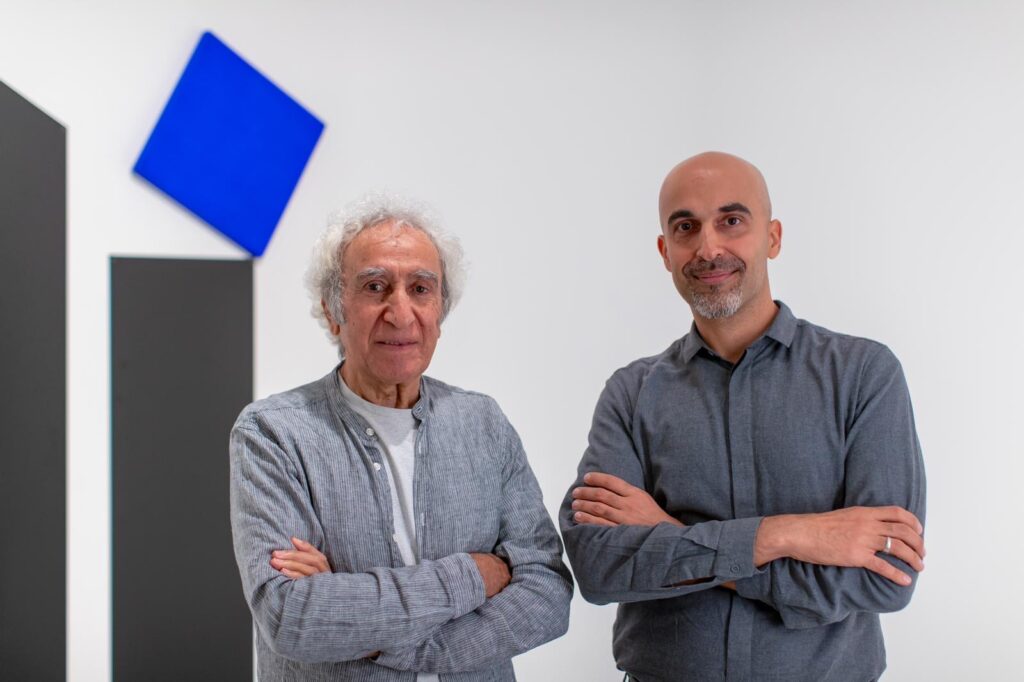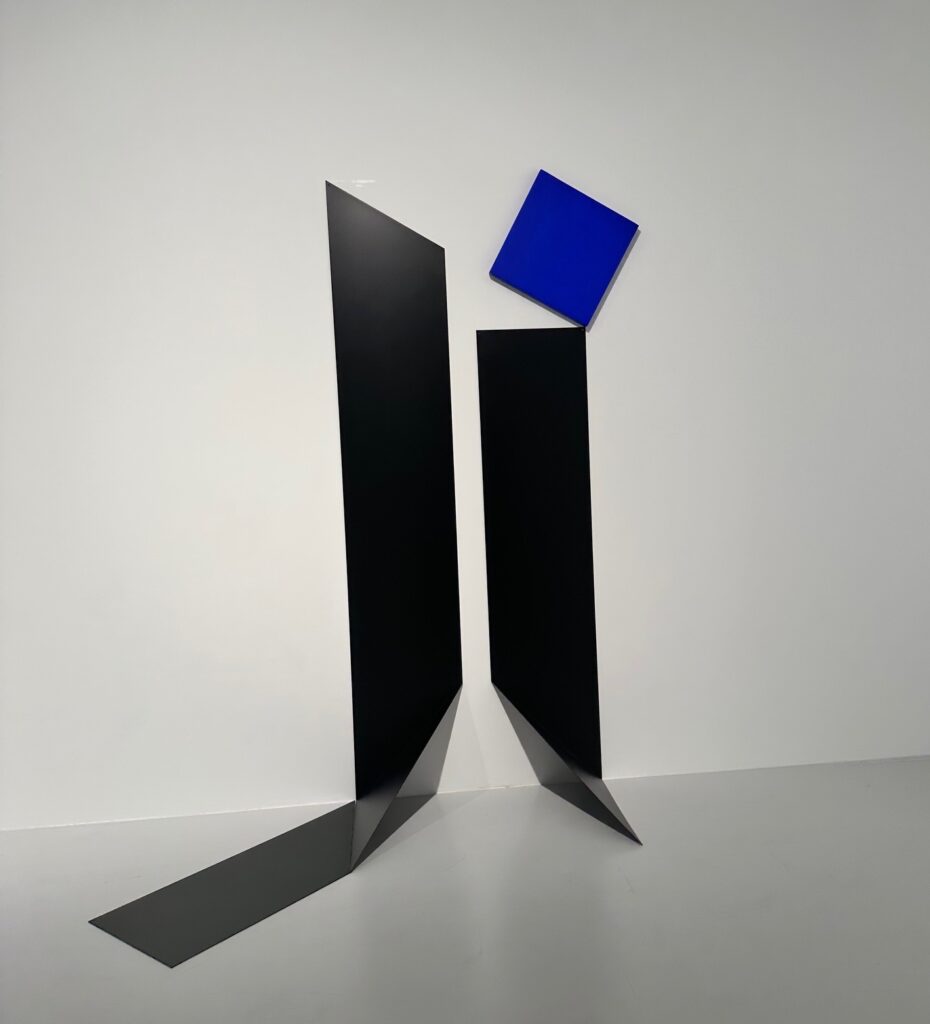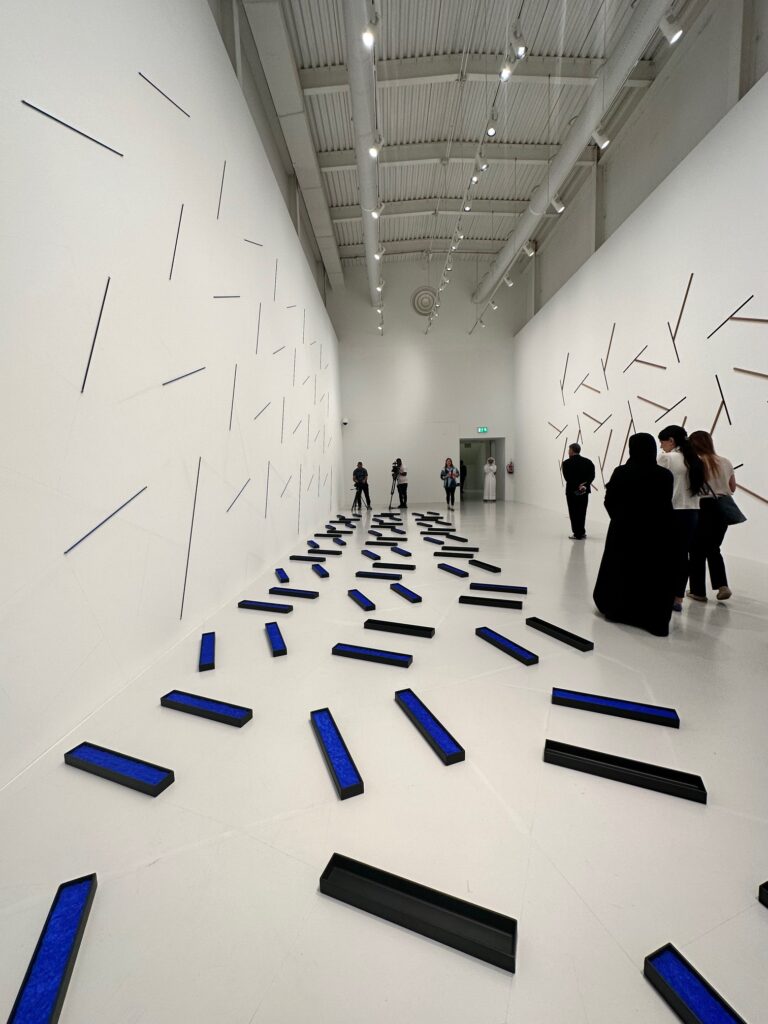Exploring the Aesthetics and Geometry of Calligraphy
In the month of October, 2023, Mathaf, the Arab Museum of Modern Art opened four captivating exhibitions showcasing the breadth of contemporary art across the Arab world. We turn the lens on Mehdi Moutashar: Introspection as Resistance, a retrospective survey of the work of a confirmed Iraqi artist whose work gives local audiences an exciting insight into Arab art.
Mehdi Moutashar: Introspection as Resistance presents a constellation of new and existing works in a wide variety of media by the distinguished Iraqi artist, in his first solo exhibition in Qatar and his first in the region in nearly 50 years.
Organised by guest curator Amin Alsaden at Mathaf, the exhibition features artworks inspired by the endless potential of Arabic calligraphy and ornamental patterns, challenging preconceived, Western-based categorisations of Moutashar’s work as Abstraction, Minimalism, or Op-Art. More than 25 artworks created over five decades express the artist’s profound understanding of the region’s aesthetic traditions and celebrate the endless potential of its geometry.
Mehdi Moutashar is originally from Babylon but has lived in France for almost 60 years of his life. He has been experimenting in geometric abstraction over a remarkable career that spans five decades. Exquisitely controlled, his works are scientific in their mathematical precision and exactitude. Despite this detailing, and perhaps because of it the artist’s practice conveys spontaneous and fleeting moments from his youth, when he witnessed mesmerising ornamentation in local mosques, shadow patterns cast by palm tree fronds, or the lines he playfully drew in the sand. His work is all about introspection which then becomes a means for challenging artistic conventions.
“Moutashar has been exploring the heritage of the Arab Muslim world specifically in the area of geometric patterns and calligraphy. What he does, is that he analyses and tries to understand the lessons or principles underlying the aesthetics of patterns and calligraphy and then translates it into radically new and contemporary works,” explains Alsaden who has curated the exhibition.
Moutashar’s first solo exhibition in Qatar presents a constellation of new and existing works in a wide variety of mediums, demonstrating how his conceptual approach bridges contemporary art with Arab-Muslim heritage.

Mehdi Moutashar’s Three 135-degree Angles Date: 2005 Dimensions: 114 x 729 x 555 cm Medium: Wood, painted wood Credit line: Courtesy of the artist and Lawrie Shabibi Gallery
The first eye catching work of Moutashar is a large installation at the entrance of Mathaf that is a true showcase of the artists eye for detail. The installation is a simple geometrical representation of a difficult calligraphic pattern. Using limited to zero decorative elements like wood grains and blue, a colour that is prominent in other works of Moutashar, the artist lets the form do the story telling with its sweeping lines. The meeting point is the hinge from which the entire installation seems to be flow out. Even if the installation is specific in its geometrical measurements, the viewers eyes seem to float across the piece trying to decipher its meaning.

Artist: Mehdi Moutashar Title: Alif Date: 2004 Dimensions: 114 x 342 x 110 cm Medium: Wood, painted wood Credit line: Courtesy of the artist and Lawrie Shabibi Gallery
The exhibition continues to other halls further within Mathaf and here they draw parallels with other works displayed within the Museum. Distilled Lessons: Abstraction in Arab Modernism which examines the meanings and methods that differentiate the way Arab artists have used abstraction from the approaches of their fellow artists around the globe, also curated by Alsaden, takes its inspiration from Moutashar’s solo exhibition in its layout and approach.
As Alsaden explains in the second room of works by Moutashar, “The layout of this exhibition is a mirror image of the layout in the previous exhibition which is Distilled Lessons, since these works by Moutashar are all inspired by Arabic Calligraphy.”

Mehdi Moutashar, One Square and One Cube Date: 2019 Dimensions: 69 x 275 x 125 cm Medium: Painted steel, painted wood, elastic thread Credit line: Courtesy of the artist and Lawrie Shabibi Gallery
“In this room (Moutashar’s exhibition) you are surrounded by two walls that wrap around you and evoke the traditions of early Arabic calligraphy. The words seem to float around you as they are placed strategically in a white backdrop, elevating the floating experience,” explains Alsaden.
The most important work here is Alef, a calligraphy construction of two letters placed ingeniously to evoke stories that help us understand their importance.

Mehdi Moutashar, Movement 9.2 Date: 2016 Dimensions: 122 x 122 x 4 cm Medium: Painted steel (laser cut) Credit line: Courtesy of the artist and Lawrie Shabibi Gallery
“Space and the measure of space is very important in calligraphy,” explains the artist himself, “There is a larger space and a smaller space, all of which are accurately positioned to arrive at the perfect structure.”
As Alsaden explains, the letter seems to float towards the viewer and the square placed at a precise angle of 30 degree has a significance. It is an accuracy regulator; the length of the letter is a multiple of the length of the square. Overall, all of Moutashar’s works seem to be a play in accuracy and detail. It seems as if the artist enjoys precision in his works of creation and finds equations to create a new structure of calligraphic recreation.

Three Squares Date: 2022 Dimensions: 127 x 180 cm Medium: Painted wood, elastic thread Credit line: Courtesy of the artist and Lawrie Shabibi Gallery
By overturning the dictates of modernist dogmas, Moutashar’s creations may be regarded as acts of shrewd defiance. Visual and spatial expressions are for him nothing but translations of mental processes cast into tangible form, inviting reflection on the interrelations between everything around us. Moutashar’s works, therefore, are traces of the artist’s incessant inquiry, generously implicating us in his tireless resistance.
Drawing Parallels
Meanwhile “Distilled Lessons”, another exhibition ongoing at Mathaf is drawn entirely from Mathaf’s unsurpassed collection and demonstrates how regional artists have drawn ideas, visual elements, and techniques from the rich and diverse heritage of the Arab-Muslim world, particularly calligraphy and ornamentation.
We loved how the curator tries to draw parallel between these two exhibitions he has curated; one that highlights a great artist of the region who draws new interpretations and another that celebrates the diversity of the artists’ works even if they are laced with a common thread, of calligraphy.
“The exhibitions were created in tandem, and have informed each other along the way. They are both organized according to similar thematic groupings, and each begin with works focusing on calligraphic abstraction, then a space dedicated to geometric abstraction, and finally a large hall exploring works of a hybrid nature, referencing patterns and Arabic letters,” says Alsaden who says that the collection exhibition contextualises Mehdi Moutashar’s practice in a longer history of abstraction in the region, and simultaneously highlights the uniqueness of his approach.

Moutashar’s C 4 30° Date: 2022 Dimensions: 97 x 214 cm Medium: Painted wood, elastic thread Credit line: Courtesy of the artist and Lawrie Shabibi Gallery
“However, the exhibitions are also treated differently in terms of how visitors can experience them. The collection exhibition aims to present artworks in a setting that evokes Arab sensibilities, and the culture’s comfort with density, rich colours, and the intimacy of darkness; each piece can be seen independently, as a precious object celebrated with its own light, but the pieces in each space equally speak to each other because of their proximity. The idea is to create a tribute not only to these artworks, but to the museum itself, with its unparalleled collection of Arab art.”
“On the other hand, when visitors enter Mehdi Moutashar’s solo exhibition, they experience a luminous space, and might feel like they are floating along with the artist’s works, which appear like these powerful precise gestures around them. In other words, they will momentarily inhabit the artist’s world, as though stepping into his mind,” he says.
Ultimately, the two exhibitions complement each other because of their differences, and as the curator believes, “both will greatly inform the visitors’ enjoyment and comprehension of each body of work.”
Images Courtesy Mathaf







